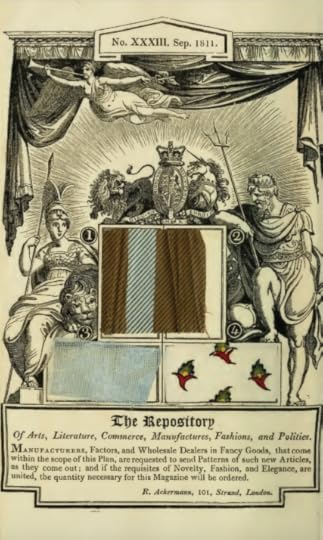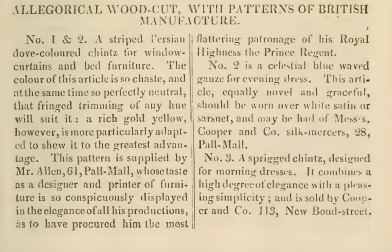Bliss Bennet's Blog, page 7
May 24, 2016
Ackermann’s Fashion Plates June 1812
Springtime brings thoughts of babies and motherhood, and thus we have yet another fashion plate featuring a young child. Unlike many earlier Ackermann fashion plates that include children, the toddler in this plate features so large as to almost obscure the details of the fashionable dress its mother is wearing. Strangely, mom is wearing gloves (of fashionable lemon) while interacting with her child! Baby has lost its little red shoe; can mother’s “small sprig of geranium placed in the hair on the left side” be far behind?

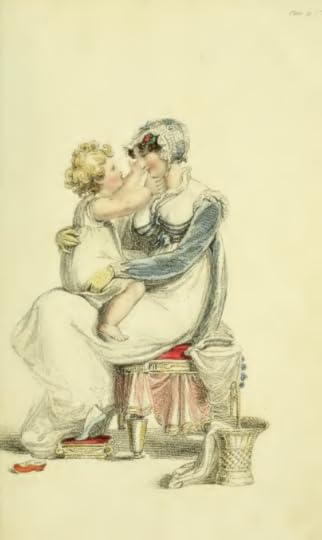
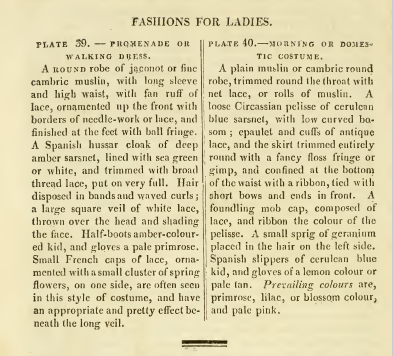
I got excited when I spied beautiful sample #4 in this month’s patterns of British Manufacture. To my disappointment when I read the accompanying description, it is not a fabric, but rather, a “specimen of the new embossed fancy paper, colored in oil, over a silver ground… recommended for the backs of books, for hand and pole screens, covering and lining boxes, card-racks, &c, &c.” Can I say I’d rather have a dress made with such a lovely pattern than a card-rack or a lined box? But I suppose fashionable Regency ladies would just have to settle for the fabric in sample #3, a “new lilac spotted sarsnet, for evening or full dress.”
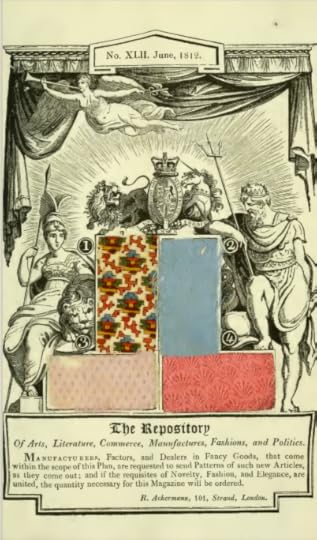

May 17, 2016
Ackermann’s Fashion Plates May 1812
This month’s first fashion plate looks almost as if it had been made over from last month’s ball gown, with its “blossom-colored” sarsnet, and its trim of “tufted Chinese silk” all down the front and about the hem. But this dress is meant for walking, not for dancing. The second plate, featuring a “Morning Dress,” looks quite fancy for casual letter writing or reading, in which the model in this plate appears to be absorbed. The lemon-colored kid gloves strike my eye as rather odd, but perhaps the celestial blue of the hat and waist ribbons was not an option for gloves?
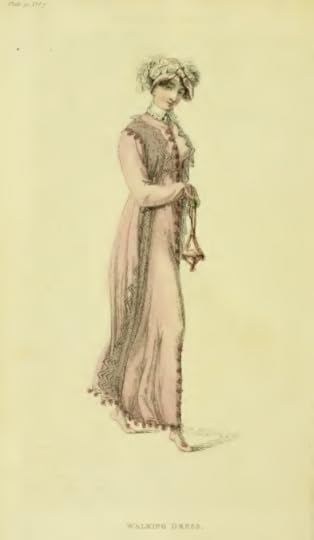
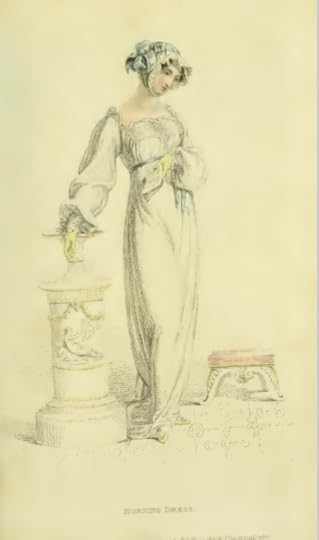
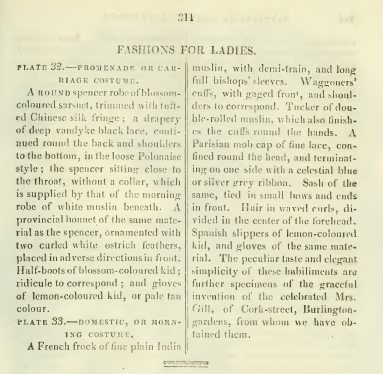
This month’s fabric samples include (for the first time I can recall) something that isn’t fabric: a trim made of “willow shavings”! This sample is shown in cream and green, but the description assures readers that Mr. Palin, its inventor, stocks the trim “in a variety of beautiful tints and colors.” Industrious ladies can use the trim not only to decorate their own hats and bonnets, but also to make “baskets and mats for the table, &c., as well as many other article both useful and ornamental.” Can you imagine a group of young Regency ladies holding a contest, to see who could come up with the most ingenious use of Mr. Palin’s willow shavings?
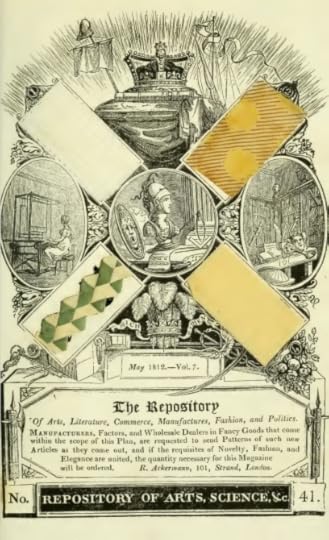

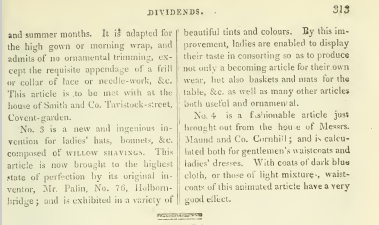
May 10, 2016
Ackermann’s Fashion Plates April 1812
April 1812’s fashion plates feature a “Morning Dress” and a “Ball Dress,” both topped by the loveliest of headgear. For casual wear, a “Flora cap” of white satin and lace; for evening occasions, a “Spartan or Calypso helmet cap of pink frosted crepe, with silver bandeaus, and embellished with tassels, and rosets” to match those on evening gown. Did those tassels and rosets make a charming tinkling noise when my lady took to the dance floor, I wonder?
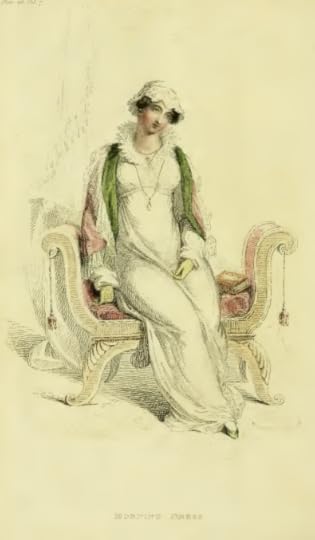
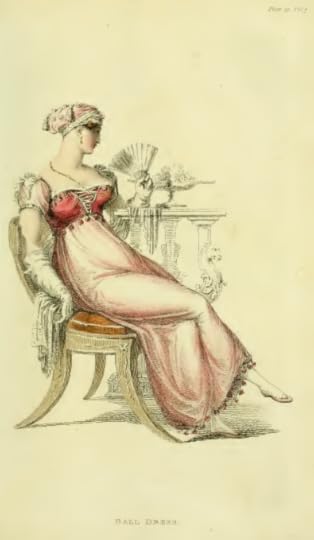
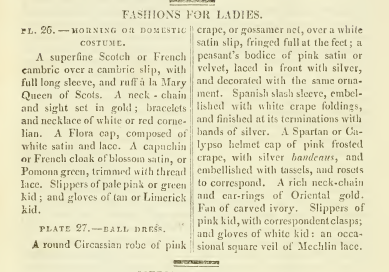
Before reading the description, I assumed the fabric in sample #1 & #2 was meant for a lady’s gown. But to my surprise, I read that it is intended not for women, but for gentlemen’s waistcoats. A popular item, it would seem, especially among members of the “Whip Club,” who “distinguished themselves by double-breasted waistcoats of this attractive article.” As the fabric resembles “tambour work,” or what appears to be embroidered netting, it seems a rather delicate choice for hard-driving bucks. But perhaps that is part of the appeal: a true pink of the ton would be able to handle his horses so smoothly that there would be no danger of tearing the fabric of his oh-so-fashionable waistcoat.
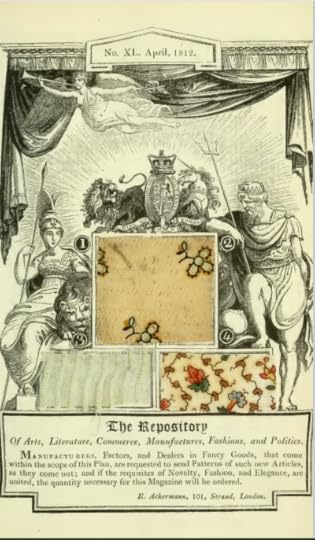

An extra plate this month, featuring an engraving of a “Ladies’ toilette dressing-case.” Equipped with not one, not two, but five separate mirrors, the dressing-case allows his owner to judge the success (or failure) of a particular hairstyle or dress adornment “more quickly and accurately than is possible with the usual accommodation.” I wonder how much Mssrs. Morgan and Sanders charged for such an extravagant piece of fashionable furniture?
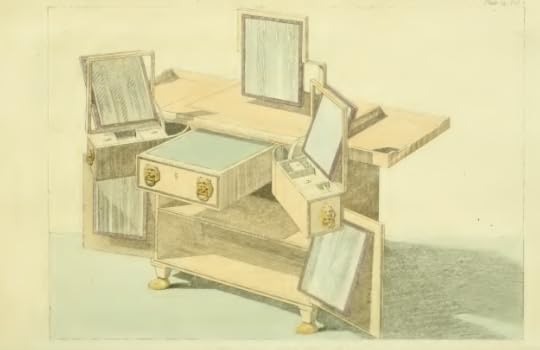
Plate 25, Vol VII, no. xl, page 240
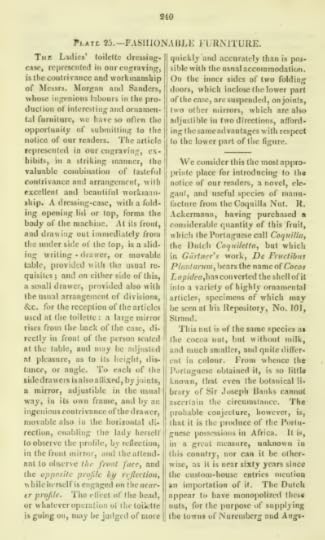

May 3, 2016
Ackermann’s Fashion Plates March 1812
White, enlivened by touches of pink, are the colors featured in Ackermann’s March 1812’s fashion plates, which depict an “Indoor Morning Dress” and an “Evening Full Dress.” I wonder if the pearls (or, for the more frugal lady, white beads) adorning the stomacher of the evening dress sat heavily on one’s chest?
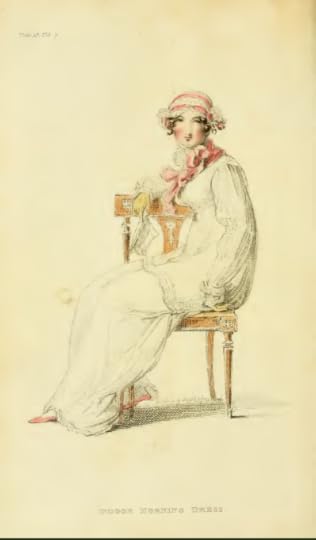

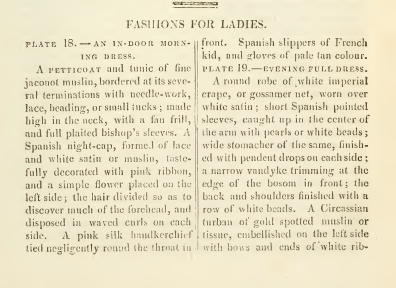

This month’s General Observations focus on the irony of current-day language to describe the dress appropriate for different times of the day:
“what will the good people say to the names applied to dress, when they are informed, that the undress of the present day consists of a comfortable kind of habiliment closed round the neck and covering the arms; that the half-dress is rather more open and exposed; and that the full-dress scarcely admits of any covering at all, bit in common language would be called complete nakedness.”
In fact, our commenter explains in a footnote, the full-dress pictured in plate 18 “is not at all a fair specimen of haut ton” because it exposes far less bare skin that do the fashionable dresses worn by the denizens of society. “[W]e could not overcome the modest objects of the artist, to representing the figure in the extreme of fashion,” an extreme in which the “whole of the bust, shoulders, and arms may be completely exposed.”
Women should not ape such fashions, our commentator recommends, for if the “object is to captivate,” “by this abrupt exposure, all those little arts which arise out of the consciousness of inspiring admiration, are at an end; what man would be ambitious to possess the confidence of a lady who freely unbosoms herself to all around her?”
I can’t help but feel that the entire column was written just so the author could crow over that particularly painful pun…

I’m struck by this month’s fabric sample #4, a “very striking and appropriate printed Marseilles for gentlemen’s waistcoats.” According to Fairchild’s Dictionary of Textiles, a “marseilles” is “a double-faced cotton quilting that is made in a plain jacquard weave with a raised, woven pattern…. Usually it is made with two sets of filling one fine and one coarse, and one fine warp. The plain ground is composed of the fine yarns, the coarse ply filling the floats to form the raised figures” (347). I’m wondering if the brown dye of the raised figures (which have a flavor of native american bird motifs, to my eye) have bled, making the plain ground appear mottled.
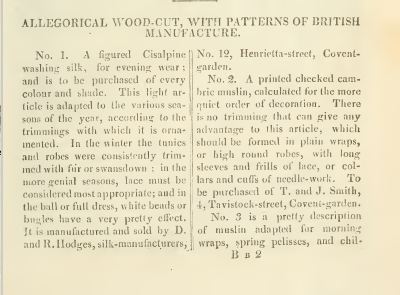
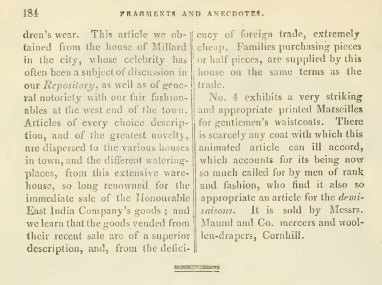
April 13, 2016
Ackermanns Fashion Plates February 1812
February’s prints feature a Ball Dress and a Walking Dress. Unfortunately, there seems to be some discoloration in Plate 11, the Ball Dress. The dress’s fancy border, sleeve bands, bodice, and the accompanying slippers are all described as “marigold” in color, but the bodice in the print looks as if the summery yellow has partially faded to a brown tone more suited to autumn. Or does the print appear this way in other libraries’ copies?
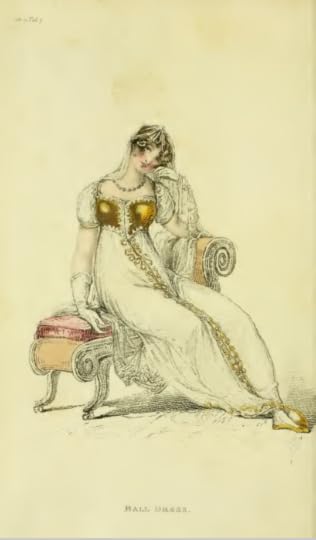
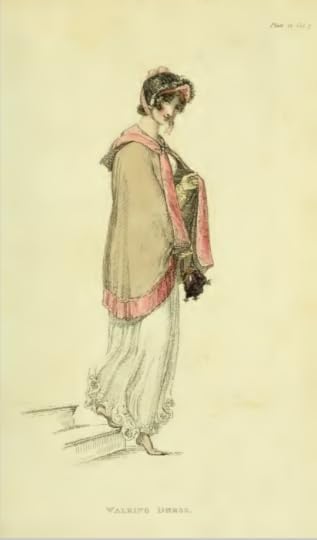
The walking costume (plate 12) also features brown, but in this case the brown seems original to the print: the “Russian mantle” is described as being made of “fine drab cloth.” The fetching bonnet, a “village hat,” is described as being “simply tied across the crown with a Barcelona handkerchief,” an accessory with which I was not familiar. According to Fairchild’s Dictionary of Textiles, a Barcelona handkerchief is “a fine, twilled silk square in solid colors, checks, and fancy designs, worn around the head or neck. Originally made in Spain and later manufactured in Great Britain for export to southern Europe, North Africa, and South America” (41). I quite admire its shade of rose, don’t you?
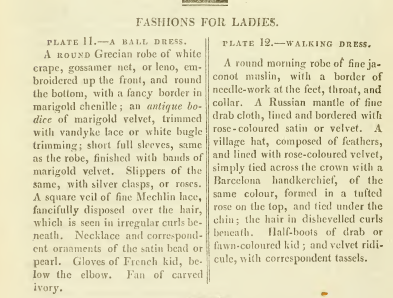
This month’s fabric sample descriptions suggest one way a Regency-era lady of fashion might while away a dull morning: by visiting a fabric warehouse. In particular, that belonging to the “celebrated Allen of Pall-Mall,” which “now classes amidst the polite morning lounges of fashionable resort.” Didn’t realize this, but according to the OED, “lounge” can refer not only to “a kind of sofa or easy chair on which one can life at full length,” but also to “a place for lounging” or to “a pastime.” Which usage do you think is meant here?
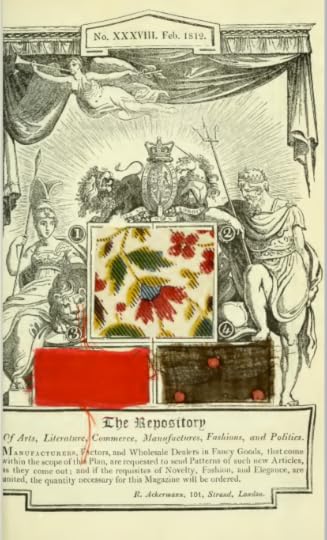
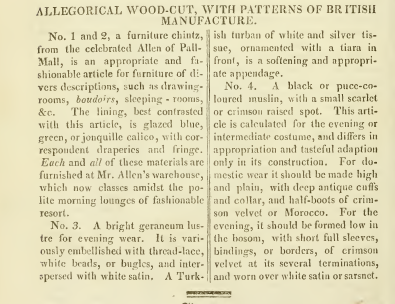
April 6, 2016
Ackermanns Fashion Plates January 1812
Ackermann’s fashion models are dressed for the cold in January 1812’s plates. The outfits worn both consist of multiple layers. For the lady in Plate 4 (“Half Dress”), both a “High Roman round robe,” a “Pomeranian mantle of silk,” and a “high standing collar of muslin or net” ; for the one in Plate 5 (“Carriage or Polish Walking costume”), a morning robe, a demi pelisse, and a pelerine. Both also rely on fur for warmth: sable fir trim on the half boots in Plate 4; “sable, oppennoch, or other tastefully contrasted fur” for the “Canonical cap” in Plate 5. Perhaps the editors suspected the spring and summer would be particularly cold? (See Pascal Bonenfant’s informative web site on “British Weather from 1700 to 1849” for more details).
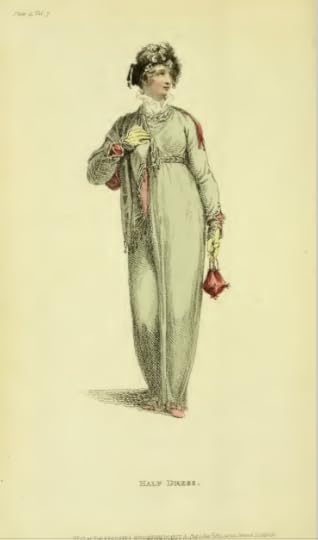

Arbiter Elegantiarum returns this month to offer an assertion that his work criticizing current-day fashion is important:
“Dress has been so seldom made the subject of serious criticism by the writers of any age or country, that the observations which have appeared under this head in the former volumes of the Repository, whatever faults may have distinguished them, must, at least, be allowed the merit of novelty.”
Even literary men cannot escape his discerning eye. AE criticizes Alexander Pope, Waller, and Marmontel for the way each dresses his heroines in “silly and cumbrous appendages of fashion,” rather than the more “tasteful” costumes of which AE approves. He concludes by vowing to continue to offer both his praise and his anathemas “with a license unlimited, but by the anxiety I feel for their best interest, and the love I bear for the sex in general.” Not sure if I were a fashionable lady, I would have found his reassurances all that assuring…
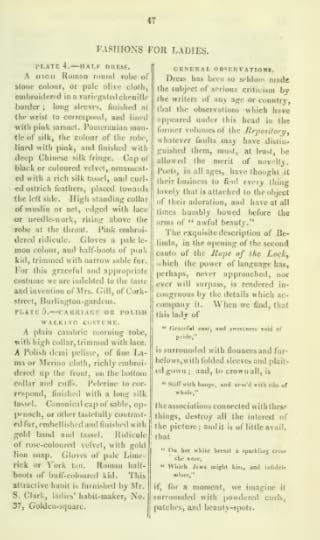
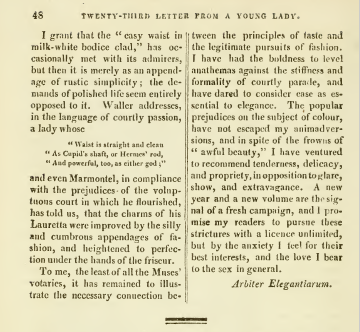
This month’s fabric samples include the longest write-up of a single company I’ve yet to see in the magazine. Praise for the “house of Millard, in Cheapside” goes on for more than an entire column; was it the largest, or most prestigious, fabric shop of the period? The copy claims it is “unrivaled, both in the variety, richness, and elegance of its supplies; and possesses, at the same time, the advantages of a superior economy.” While some of Millard’s goods can be had for as low as a single shilling per yard, its Indian shawls can cost up to one hundred and fifty guineas!

Ackermann’s also seems prescient in featuring a “fine Merino wool of Wellington brown” amongst this month’s samples—did someone have the inside scoop that General Wellington would be raised from an earl to a marquess the following month?
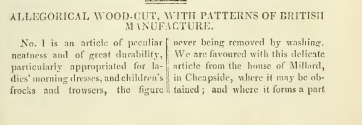

March 16, 2016
Ackermanns Fashion Plates December 1811
Can’t remember seeing a riding dress featured in Ackermann’s Fashion plates before. This one is rather dour, at least in color: “a pale lead or olive tinge.” Better ride a strikingly-colored horse if you put that gown on, else you’ll be likely to fade right into the background of the dank English countryside…
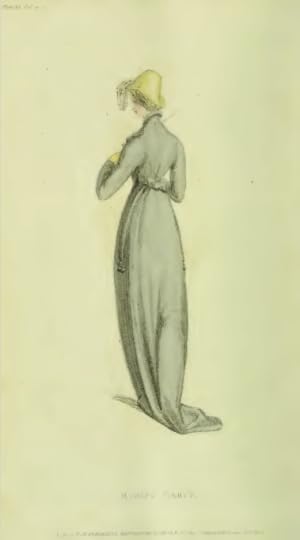

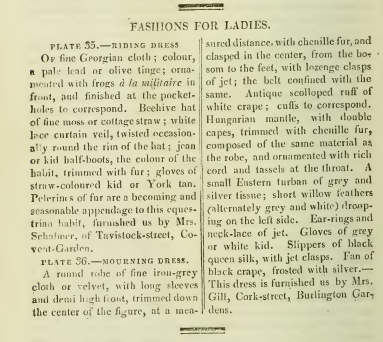
I’m in love with the first of this month’s fabric samples, a “cerulean blue and white embossed satin.” Dreaming about drifting about a ballroom in a dress made from that one, I am. The other dress fabrics look pretty dreary in comparison…
Check out the note about the creators of the tambour work on last month’s fabric sample—a potential plot detail for someone’s next Regency novel, perhaps?

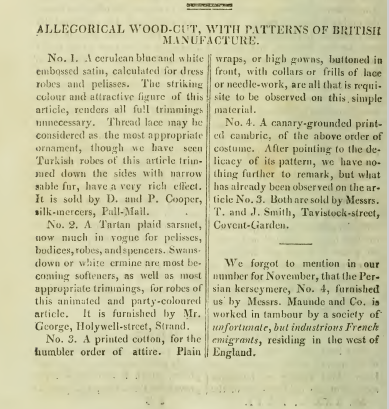
March 9, 2016
Ackermanns Fashion Plates November 1811
Arbiter Elegantiarum blows November’s chills away with a blast against the overuse of fur in winter fashion. Muffs come in for particular scorn: “these monstrous muffs, or rather muffles (for they completely handcuffed the poor women).” At least, though, muffs have been abandoned, suggests Arbiter; alas, the ungainly fur tippet is still to be found, that once “graceful ornament of a winter dress” which has, unfortunately, “swelled itself out into a large plaister of fur, which covered the back and shoulders, and completely destroyed the beauty of the figure.” What woman would want to wear a garment that Arbiter compares to “the collar of martyrdom, which was formerly fixed upon the neck of the unfortunate victims of the infernal Inquisition”? Not me!
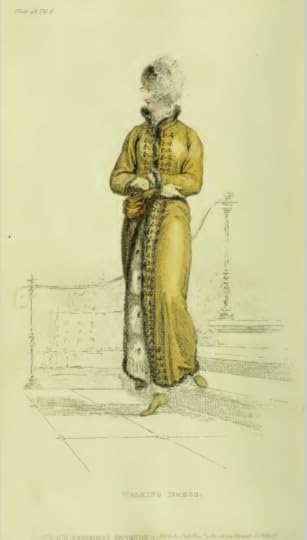
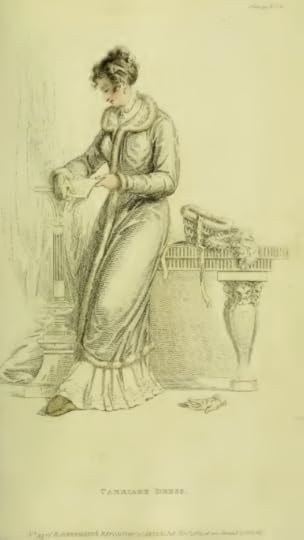
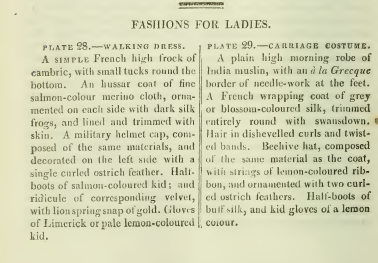

Fall colors grace this month’s fabric samples: fawn, rusty brown, and yellow gold. Sample #4, a “Persian kerseymere, worked in tambour,” is “much in vogue with our male fashionables.” The photograph here is not very clear; I’d love to see a better close up of the tambour (embroidery) work, wouldn’t you?
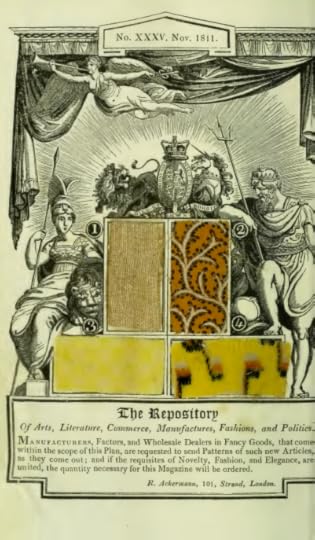
Fabric samples Nov 1811


March 2, 2016
Ackermanns Fashion Plates October 1811
Did our fashion columnist invent a new word to describe this month’s first fashion plate? What do you make of the following:
We take it upon us to remark, that the length of the waist in this plate may be considered in the extreme, as few of our fair country-women seem disposed to depart from a becoming modiocrity in this particular.
I’m still struggling to parse this sentence. At first, I assumed that “modiocrity” was a simple typographic error, meant in fact to be “mediocrity” (my spell check keeps changing it to that, in any case!). But can a “mediocrity” ever be described as “becoming”? I’m charmed by the idea that our columnist has combined mediocrity and modish to come up with the coinage “modiocrity.” But I’m still left scratching my head; why does the writer feel forced to point out that the low waistline of this round French robe is “in the extreme” if he believes few ladies likely to change from the current style of high waists?
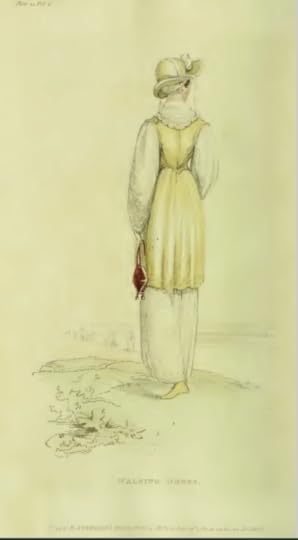

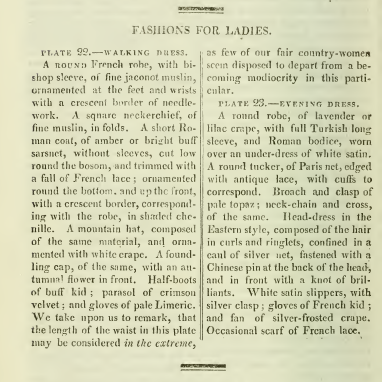
Some colorful fabrics for gowns, some for evening dress and some for day dress. I’d like to see a day gown made from sample #4; I’m a fan of combinations of brown and pink. And the name—”palm-leaf imperial striped cambric”—is impressive, too!
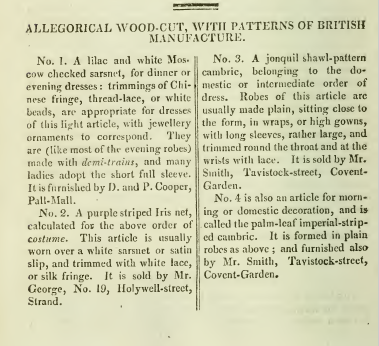
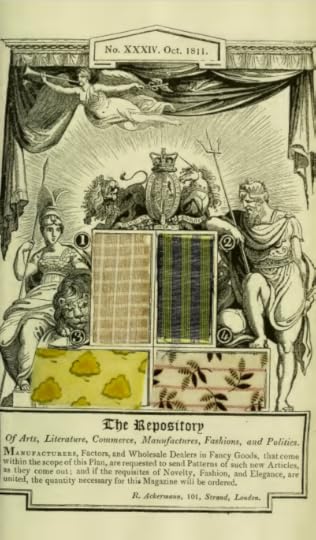
February 10, 2016
Ackermanns Fashion Plates September 1811
Walking continues to be popular amongst the ladies of fashion; for the third month in a row, Ackermann’s fashion plates feature a walking or promenade costume. Autumn is in the air; our walker this month appears in a few more layers (and a higher neckline) than last month’s did. And the hat of our reader is adorned with “autumnal flowers” as well as matching blossom-colored ribbons. Do you think all those ruffles might prove a distraction from her book?
Only a small extra note this month, noting the “complete revolution” in ladies’ shoes. Though we hear that “Rodwell’s brass military heel and copper fastenings are quite the ton,” as is “the gold and jet clasp to the regent slipper,” we have no pictures of same, alas. Perhaps some might be on display at the Victoria & Albert Museum’s special exhibition, Shoes: Pleasure and Pain. Alas, the exhibition ends this week. Have any readers had a chance to take it in?
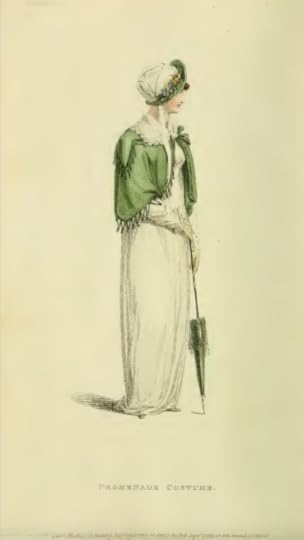
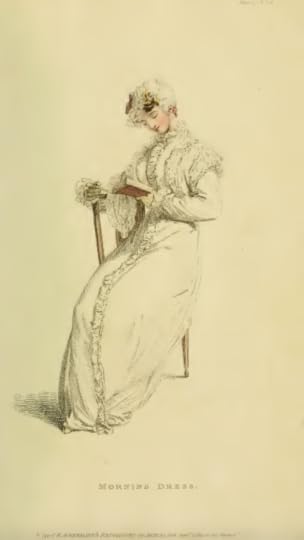
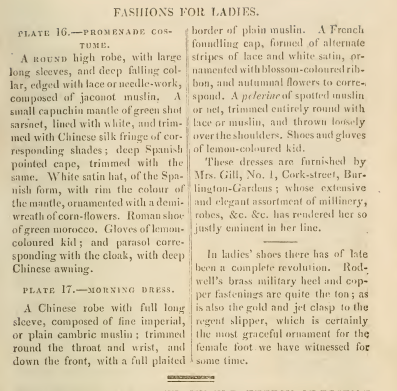
I’ve never heard a color described as “chaste,” have you? But this month’s fabric sample (#1) is so-labeled, in reference to the myriad choices of trim one can pair with it. How odd! The fabric itself, a striped chintz suitable for window or bed curtains, is lovely, and it is made by Mr. Allen of Pall Mall, whose skills have “procured him the most flattering patronage of his Royal Highness the Prince Regent.” Yes, you, too can shop where the prince does!
